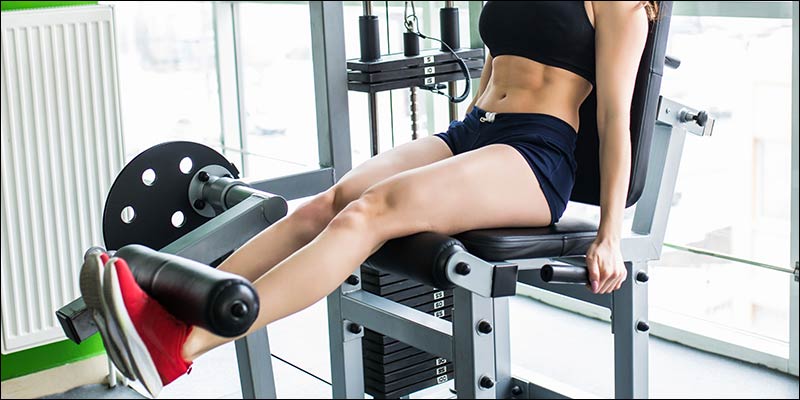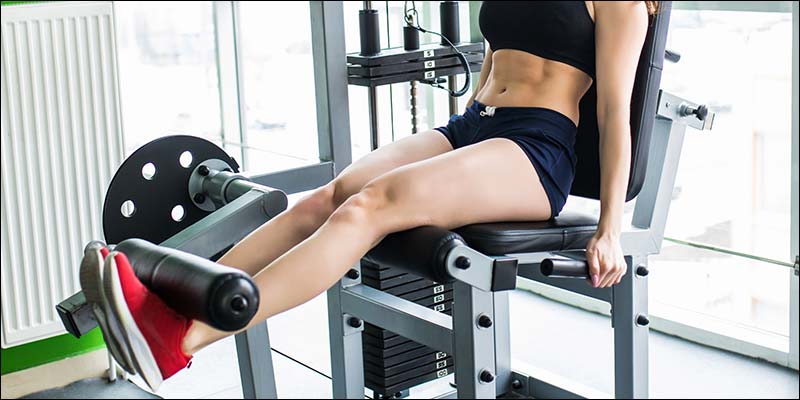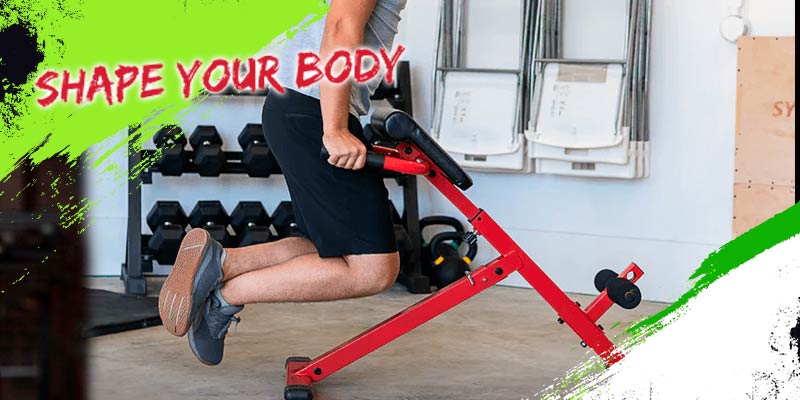Roman Chair exercises have been around for quite some time, offering a versatile and effective way to strengthen various muscle groups and improve core stability. In this article, we will explore the history, benefits, techniques, workout routines, and much more related to Roman Chair exercises.
About Roman Chair
Roman chair exercises are conducted using a versatile piece of equipment called the Roman chair. These exercises harness your body’s weight as resistance to target and fortify the glutes, back, abs, and upper legs.
Roman chairs typically take the form of compact benches, often equipped with padded seats and foam rollers that enable you to recline and secure your position while performing the exercises.
Benefits of Roman Chair Exercises
Incorporating Roman Chair workouts into your fitness routine is a great way to reap a variety of benefits. One of the primary benefits is the notable enhancement of your lower back strength. Specifically, exercises like hyperextensions are highly effective in engaging these frequently neglected muscles. Strengthening your lower back in this manner helps minimize the risk of experiencing back pain and injuries.
Roman Chair exercises offer a wide range of benefits, including:
- Improved posture
- Enhanced lower back strength
- Strengthening of the core muscles
- Increased stability and balance
- Reduced risk of back injuries
- Glute and Hamstring Development
10 Best Roman Chair Exercises

Below, you’ll find 10 exercises that can assist you in building lean muscle:
Side Bends
To initiate the exercise, lie on your back with your feet positioned against the footrests of the chair. You have the option of either positioning your arms behind your back or crossing them over your chest, both of which are equally effective. While maintaining the stability of your torso and legs, gradually shift your upper body to the left side, then return it to the center. Perform the same movement on the opposite side to complete one full repetition.
Kneeling Preacher Curls
To start the exercise, position your knees on the chair pad and lean slightly forward. You can also use a small cushion on the front to support your chest. Grasp the handles with your palms facing outward and lean forward until your arms are fully extended. Then, slowly raise the dumbbell or barbell until your elbows reach a 90-degree angle.
Back Extensions
To begin, position the chair’s pad at hip height and lie face down with the chair in front of you. You can either cross your arms over your chest or place them on the armrests for added support. Push your feet against the footrests and gently raise your upper body until it is parallel to the ground. Once you’ve achieved this position, hold it for two to three seconds before lowering your upper body back down. Remember to maintain a deliberate and controlled movement throughout.
Incline Push Ups
Begin by adjusting the chair pad to chest height. Then, assume a push-up position, with your hands resting on the handles located on either side of the roller pads. For a greater challenge, you can keep your feet on the ground, or if you require support, position them against the footrests. When lowering your torso toward the ground, ensure that your elbows remain close to your body and maintain a deliberate and unhurried pace.
Hanging Dips
The starting position for this exercise mirrors that of the incline push-up. Adjust the pad to chest level and grasp the handlebars on either side. Next, position your legs so that they are suspended, allowing you to hang from the chair. Maintain a consistently engaged core and perform the exercises with controlled, deliberate movements.
Roman Chair Sit-Ups

To execute this exercise, secure your feet on the footrests and recline backward. Ensure your back maintains contact with the chair, and as you ascend, allow your arms to extend towards the ceiling. Alternatively, you can cross your arms over your chest or grip the handles with both hands. It’s important to keep your hips firmly in place on the chair during the entire exercise, and if needed, you can use a small cushion for lower back support.
Straight Leg Raises
Grip the handles with both arms, keeping them extended and slightly bent at the elbows. Maintain a strong hold on the handles while keeping your core engaged as you bring your legs from the initial position toward your chest. Strive to align them parallel to the ground, and then slowly lower them to the starting position. Be sure to keep your upper body steady throughout the exercise and concentrate on activating your abdominal muscles as you perform it.
Isometric Glute Hold
Begin by setting the ankle pads at a position that lines up with the groin pad in the center of the chair. Then, recline with your abdomen against the chair and extend your legs outward on the ankle pads. Ensure your upper body remains upright, and grasp the handles with both hands. For a more challenging experience, position your hands beside your body and rely on your core strength to maintain the correct posture.
Twists
Roman Chair twists are a great way to work on your oblique muscles. They help in achieving a well-defined waistline and enhanced stability.
Oblique Crunches
Oblique crunches target the oblique muscles, aiding in the development of a strong and sculpted midsection.
Safety Measures for Roman Chair Exercises
It is crucial to perform Roman Chair exercises with proper technique to avoid injuries. Always maintain a neutral spine position, engage your core, and use controlled movements. If you’re a beginner, consider seeking guidance from a fitness professional.
Below are a few safety guidelines:
- Warm-up
- Proper form
- Start with low intensity
- Don’t overextend
- Use proper resistance
- Avoid jerky movements
- Breathing technique
- Progress gradually
Workout Plan for Roman Chair Exercises
Beginner’s Routine
For beginners, start with low reps and gradually increase the intensity of your exercises.
Intermediate Routine
Intermediate individuals can incorporate more challenging variations and increase the number of sets and reps.
Advanced Routine
Advanced practitioners can add weights and perform complex exercises for an even greater challenge.
Roman Chair Exercises for Beginners

Initiating Roman chair exercises provides an excellent avenue for novices to enhance their core, lower back, and glute muscles. Here, we present a selection of Roman chair exercises tailored for beginners:
1. Roman Chair Leg Raise
The Roman Chair Leg Raise is an excellent workout that focuses on your lower abdominal muscles and hip flexors.
2. Roman Chair Hyperextensions
Roman Chair Hyperextensions are an excellent exercise for building strength in your lower back, glutes, and hamstrings.
3. Roman Chair Knee Raise
The Roman Chair Knee Raise is an excellent exercise that focuses primarily on your lower abs, while also engaging your upper abs and obliques. It’s an effective method for enhancing core strength and overall stability.
4. Roman Chair Oblique Twists
Roman Chair Oblique Twists are an excellent exercise that specifically targets your obliques, the muscles on the sides of your abdomen. They are highly effective for toning your midsection and enhancing core stability.
Incorporating Roman Chair Exercises into Your Fitness Regimen
Roman Chair exercises can be a valuable addition to your existing workout routine. Find the right balance and integrate them effectively to maximize their benefits.
Common Mistakes to Avoid
While the appeal of Roman chair exercises is their capacity to revolutionize your fitness journey, it’s vital to stay mindful of common pitfalls that could impede your progress. As you set forth on your path to a stronger and healthier body, avoiding these missteps will serve as your guiding light.
- Ignoring Correct Form and Technique
- Letting Momentum Dictate
- Neglecting Warm-Up and Cool-Down
- Exceeding Your Limits
- Not Prioritizing Proper Breathing
Progress Tracking of Roman Chair Exercises
If you’re a newcomer to the Roman chair, begin with lower intensity and progressively raise it as you enhance your strength and stability. I highly advise initiating the exercises with just your body weight. Once you feel comfortable, you can slowly amplify the intensity, resistance, or duration of the workout. It’s essential to avoid pushing yourself too hard too soon, as this can increase the risk of injury.
Diet and Nutrition for Optimal Results
A balanced diet is crucial to support your workout efforts. Consume a diet rich in protein, healthy fats, and a variety of nutrients to aid in muscle recovery and growth.
Variations and Modifications
Explore different variations and modifications of Roman Chair exercises to keep your routine exciting and challenging.
Targeted Muscle Groups
Roman Chair exercises target various muscle groups, including the lower back, core, glutes, hamstrings, and obliques. Understanding which muscles each exercise targets can help you tailor your workout to your specific fitness goals.
Conclusion
Roman Chair exercises are a fantastic addition to any fitness routine. They provide numerous benefits, from enhancing core strength to improving posture. Remember to start with the basics, maintain proper technique, and gradually progress to more advanced routines for the best results.
If you’re ready to take your fitness to the next level, explore the world of Roman Chair exercises and experience the transformation for yourself. Get started on your journey to a stronger, healthier you!
FAQs
Q1. Is the Roman chair a good exercise?
If your objective is to develop strength, you’ve come across the perfect piece of equipment. The bench’s angle enables a greater range of motion for various abdominal and back extension exercises, providing you with greater benefits for each repetition.
Q2. Who should not use a Roman Chair?
However, individuals who have previously been diagnosed with spinal stenosis, other degenerative conditions, or ongoing lower back pain may be at risk of worsening their symptoms by performing the Roman chair back extension exercise to the point of reaching or exceeding their full range of motion.
Q3. Is Roman Chair safe?
Roman chair back extensions focus on the muscles around the spine in the back. Nevertheless, performing Roman chair back extensions repeatedly can place additional strain on the lower back and may lead to discomfort in other areas, including the hips or neck.
Q4. How often should I incorporate Roman Chair exercises into my routine?
The frequency depends on your fitness goals, but 2-3 times a week is a good starting point.
Q5. What should I eat before and after Roman Chair workouts?
Balanced meals containing carbohydrates, protein, and healthy fats are recommended for energy and recovery.
Q6. Can Roman Chair exercises help with lower back pain?
Yes, when performed with proper form, they can strengthen the lower back and alleviate pain.

